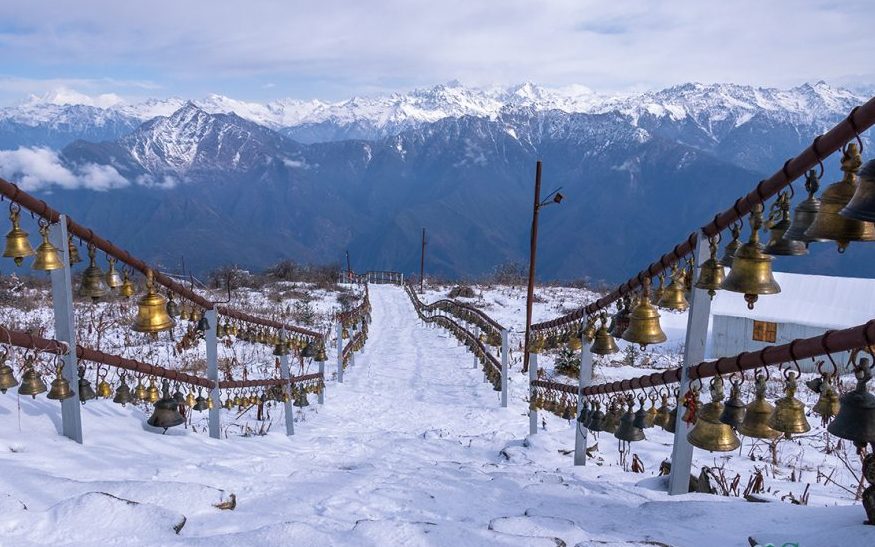Experience of Lifetime :Pathivara Temple

The number of internal and external pilgrims has been increasing in Pathibhara, an important tourist destination from a religious point of view. Branch pathibhars have been set up at various places in the east, including the main pathibhara in Taplejung. Everywhere you look today, the tide of protectionist sentiment is flowing.The main pathibhara is at the confluence of Fungling Municipality, Faktanglung and Sirijangha Village Municipality of Taplejung. According to the statistics of the Pathibhara Devi Temple Area Conservation and Promotion Committee, the temple, located at 3794 meters, reaches four lakh annually.
Although autumn and spring are the best seasons to visit Pathibhara, pilgrims keep going for twelve months. Lately, Pathibhara has been developing as a center of multi-religious faith. People of different castes, religions, cultures and sects have faith in Pathibhara. From Mechi to Mahakali, pilgrims from Sikkim, West Bengal, Bihar, Uttar Pradesh, Bhutan and Bangladesh come here.

From the Pathibhara hill, which is also being developed as a natural lookout tower, the view of the beautiful gorges and gorges formed by the silver-shining mountain range to the north is breathtaking. Kanchenjunga and Kumbhakarna can be interviewed right in front of the eyes, while the mountains like Mount Everest, Lhotse, Choyu, Makalu can be seen from a height of eight thousand meters. Similarly, most of Panchthar and Ilam, Terhathum, Sankhuwasabha and Solu including Fungling Bazaar as well as various parts of Sikkim and West Bengal of India can be seen.With the development of publicity and infrastructure, it has become very easy to reach Pathibhara. Fungling Bazaar is reached by traveling 237 km of paved road from Birtamod in Jhapa.
From Phungling Bazaar, you can reach Kaflepati by taking a taxi 4 km paved and 8 km unpaved. From there you have to walk for about three hours to reach the temple. From there, in the forest of Kanchenjunga National Park, you can see the rare wildlife including Rhododendron and Danphel and when you climb the hill, you can’t find any way to cross the road. You can also fly from Kathmandu three days a week.The importance of Pathibhara has increased due to the goddess present there. Today, Pathibhara is known as the Goddess. “Actually, Pathibhara is not the name of the goddess but the name of the place,”According to legend, the name of this goddess is ‘Panchakanya Raktakali’. Legend should also be considered as the basis for their origin.
Beliefs

In ancient times, there was a sheepfold and there were thousands of shepherds. While moving the herd, the shepherds reached the hill (now near the temple). The sheep were taken to a nearby pond to be watered and after drinking water in the middle of the day, the shepherd fell asleep. Legend has it that all the sheep were lost when they woke up and were not found for two days. After the shepherds had seen the goddess in a dream and promised to sacrifice the sheep, the next day all the sheep were sacrificed. Then the goddess arises .According to Kiranti beliefs, the context of Pathibhara can also be linked to Mundhum philosophy. The Kirantis call Pathibhara ‘Mulumalungma’. According to the writer Rajeshwar Thapa, during the Mahabharata period, a Limbu sage named ‘Rising’ lived in a hill range in Mukumlung (Pathibhara) doing penance.
After the battle of Mahabharata, Bhimsen was sent to take the sage Siring to the Mahayagya organized by King Yudhisthira. It is mentioned in the book ‘Pavan Pavitra Mukumlungma’ written by Thapa that Bhimsen got the vision of Yuma (Goddess) there.This also makes it clear that Yuma’s destination is Pathibhara. Even Buddhists have deep faith in Pathibhara. The Sherpas consider Pathibhara as the goddess of ‘Rakta Sedingma’ and ‘Majilamtama’. According to Jigdol Lama, the prayers were recited wishing happiness, peace, life and health and the mantra of ‘Acharya Guru Padmasambhava’ was written on the flagpole. He says, ‘Pathibhara is no longer just a temple or a place to visit, but has developed into a culture.

Pathivara Temple
People had to stay in the barn. They had to take shelter in the shed and in the base of the tree. But now there are plenty of hotels. No problem eating and living. The road has been upgraded. There are two committees working for the promotion of Pathibhara. The Pathibhara Devi Temple Area Conservation and Promotion Committee formed at the community level in 2043 BS and the Pathibhara Area Development Committee formed by the government are working for infrastructure development and publicity .In the East, Pathibhara has developed as a culture. Pathibhara is being established as a must-visit place. There is a belief that aspirations will be fulfilled after Pathibhara Darshan. Many people say that they have achieved success in various fields after visiting Pathibhara.

Due to the popularity of Pathibhara, branch Pathibhara temples have also been established in various districts of the East. Those who cannot walk on the main path worship there. Patibhara temples have been set up in Kutidanda of Ilam, Chauli of Jhapa, Pau Pathibhara, Harise of Tehrathum, Basantapur, Tute Deurali, Chowki Bazaar of Sankhuwasabha and Siddheshwari. From all these places, one can see the main path of Taplejung.
Comment Here!